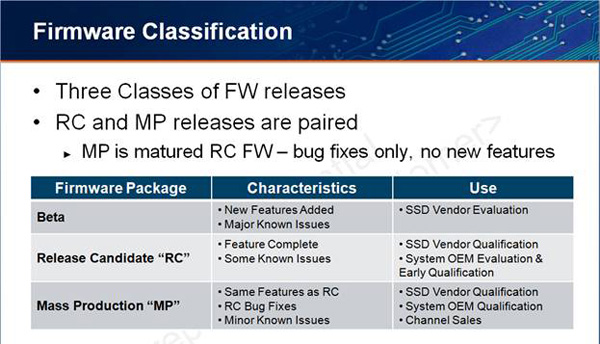Understanding SandForce's SF-1200 & SF-1500, Not All Drives are Equal
by Anand Lal Shimpi on April 16, 2010 11:30 AM ESTIt’s a Mad World: Not All SF-1200s Perform Alike
OCZ was the first from our community to really embrace SandForce. It’s my understanding that the two companies have a very close relationship, and OCZ has committed a lot of resources to SandForce and its products. OCZ took the early risk that others would not. While other companies are working with SF today, OCZ appears to have been the first from the SSD makers we cover on the site.
In exchange for their cooperation and support, SandForce gave OCZ a couple of things. First was the unique SF-1500 used in the Vertex LE at competitive prices (and minus some of the enterprise features). This gave OCZ a huge head start on the competition. The second thing SandForce gave OCZ was the rights to an exclusive firmware for the SF-1200. This firmware would give OCZ the small file random write performance of the SF-1500, but with the rest of the feature set of the SF-1200. This special firmware is going to be used in the upcoming Vertex 2 SSD.
The rest of SandForce’s customers would get the standard SF-1200 firmware, which allows the drive to run at 10,000 sustained 4K random IOPS. Other SF-1200 drives from OCZ, such as the upcoming Agility 2, would also use this standard SF-1200 firmware. The special firmware is only for the Vertex 2 at this point.
SandForce’s firmware has been in release candidate (RC) stage for the past couple of months. Internally SandForce calls this version 3.0.1 and has communicated to all of its partners what RC vs. MP (mass production) firmware entails:

This slide is shared with all SF partners.
Two things are true about this RC firmware: 1) it doesn’t limit small file random write speed on the SF-1200, and 2) there is a known reliability issue that could result in a dead drive (similar to what happened to my Vertex 2 Pro earlier this year).
And here’s where things get messy. SandForce distributed 3.0.1 to all of its partners (so much for that exclusivity agreement), and some of its partners have decided to sample reviewers or even ship based on 3.0.1. Note that even OCZ’s Vertex LE shipped using the SF-1500 version of this firmware. If SandForce indeed distributed the above slide to all of its partners, no drive should've shipped with RC firmware. That's a separate issue entirely and I've been working with both SandForce and the companies involved to see what we can do about curbing this (or at least get me the information so that I can make it clear when a product is using non-MP firmware).
The Corsair Force drive that has been sent out for reviews and that’s currently shipping today uses SandForce’s 3.0.1 firmware.
Naturally, I called up Corsair to figure out what’s going on. Corsair explained to me that the reliability problem was related to a power saving feature on the controller that Corsair simply disabled and thus avoided the issue entirely. I have yet to find a repeatable way to reproduce the bug, but the power data from our testing corroborates what Corsair is saying:

Corsair’s drive uses more power than OCZ’s Vertex LE. While it could be for a number of reasons, it’s apparently due to this power saving feature being disabled. Unless I’m wrong, Corsair appears to have circumvented the known reliability issue and is shipping product it feels is safe into the market.
Now we get to the other problem. The performance of 3.0.1 is the same as OCZ’s exclusive SF-1200 firmware, because the firmwares are the same. However SandForce has recently released its first MP firmware: 3.0.5. This firmware, as you’d expect, caps small file random write performance on all SF-1200 drives except for the Vertex 2 in accordance with SandForce’s agreement with OCZ. The SF-1500 version of this firmware doesn’t change performance, but it does supposedly fix the reliability problems and is available for Vertex LE owners here.
Corsair is currently testing the 3.0.5 revision for its drive but hasn’t shared it with me yet. Corsair wasn’t aware that performance dropped with this revision until I called yesterday. The release notes don’t indicate anything of the sort, Corsair was kept completely in the dark on this. Why didn’t SandForce tell Corsair? Because although it drops performance, the new firmware still runs the SF-1200 at its intended spec. The chip will continue to perform as advertised, just slower than with the RC firmware and slower than OCZ’s Vertex 2.










81 Comments
View All Comments
cactusdog - Friday, April 16, 2010 - link
I hope this isnt a case of bait and switch. Did they make a few parts with the quality controller then once the reviews are up switch to the cheaper controller for the masses? We've seen it before.....aconu - Saturday, April 17, 2010 - link
HelloI purchase an 200GB OWC drive the first day of their availability.
Unfortunately, i encountered troubles with the drive (growing I/O errors over one week of use, until heavy data corruption and unbootable OS). After tree secure erases, and tree weeks of repeated symptoms, i decided to return the SSD.
The drive was unavailable until yesterday, and suddenly the specs changes.
That's mean OWC will going to replace my drive with a lower specs one ?
willscary - Saturday, April 17, 2010 - link
I was told that ALL Mercury Extreme SSDs now utilize the Sandforce 1200 controller.eva2000 - Saturday, April 17, 2010 - link
Thanks Anand great info, saved me alot of $$$ as i wait and see, already got a 256GB Crucial C300. Was thinking of getting OWC 100/200GB but last month emailed them to ask about their units and compatibility list and they said they mainly cater to Mac users so OWC SSD has no guarantee for compatibility on PC systems. That already put me off unfortunately.skimike - Tuesday, June 15, 2010 - link
How did you perform your secure erase? The last time I contacted OWC about ANY utilities for the Mercury Extreme drives, their tech support had no clue. They didn't even know what a secure erase was. The guy I talked to told me to "write 0's to the entire drive".et01267 - Sunday, April 18, 2010 - link
Interesting, I also ordered the 200GB Mercury extreme from OWC/Macsales a couple of days ago and there was a delay in availability (and then the specs on the site were changed). However, my invoice states:200GB OWC Mercury ExtremeSSD EntRAID 200GB Mercury Extreme RAID-Ready Enterprise Class SSD 2.5" Serial-ATA 9.5mm Solid State Drive. High Performance internal storage. Fastest read and write times of any SSD available today! 10 million hours MTBF. 5 Year OWC Warranty.
So, did will I get a Sandforce 1500 or 1200 controller? I should find out tomorrow when it arrives.
In the meantime, I'd appreciate you putting me in touch with your contacts at OWC.
Thanks for the informative, if somewhat ill-timed (for me) article.
willscary - Monday, April 19, 2010 - link
This was exactly what happened to me. Check with the website and see what their current specs are. I was in the exact same boat and my SSDs had already shipped. When I called OWC, it took a while, but they did admit that all Mercury Extremes are now utilizing the Sandforce 1200 controller. They got their product reviewed glowingly with one controller and used that controllers specifications, then changed hardware without telling those of us who had already purchased and were waiting for delivery. I was upset about the deception and the failure to offer a discount, as the 1200 costs $100-150 less than the 1500 (per Digitalloyd's update from yesterday). By the way, this digitalloyd seems to have NO problem with this practice!bludragon - Friday, April 16, 2010 - link
"In a population of 10,000,000 controllers, with a rating of 10,000,000 hours, the probability is that 1 unit would fail in an hour. The SF-1200 would have 5 units fail in the same time. The failure probability drops as the number of controllers drops (SF won’t be shipping anywhere near 10M of these things)."This make no sense as it implies that somehow sandforce producing more controllers after they shipped mine is going to reduce the lifetime of my controller.
I think what you mean is that MTBF is listed for a single device. If I use 2, then the MTBF of the 2 combined will halve, and so having such high figures is relevant.
Lifted - Friday, April 16, 2010 - link
MTBF is meaningless with 1 or 2 drives. It's meant for large Enterprise customers and data centers where they may have thousands of drives. These customers need to know how often to expect drive failures in order to know how many resources need to be dedicated to this (personnel and spare drives).The strange thing is that Anand has been reviewing hard drives and SSD's for so many years now, with direct access to the manufacturers, but he never once asked what MTBF was. Why did he only find it strange now when hard drives have always had 1,000,000+ hour MTBF ratings?
Anyway, nice article. Keep them coming.
pzkfwg - Friday, April 16, 2010 - link
I suppose this stat can be converted into a probability which would be relevant to a single drive. Indeed, saying that "1 drive out of 10,000,000 will die within an hour of operation" means exactly the same thing as "you have 0,00001% chance of having your single drive dying within its first hour of operation" which is kind of relevant to a single drive and isn't linked to the number of controllers produced by SandForce.Out of this number, there is probably a way to have a more useful probability such as the chance of having your drive fail within its first two years of operation, but I don't know how to compute it (maybe a so called "normal" distribution or something would be the key).